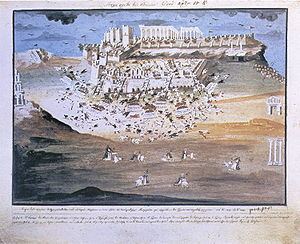Location Athens, Greece | ||
 | ||
600, later increasing to 3,000 Muslim inhabitants of Athens, later Vrioni's army Result Greek victory, surrender of the Acropolis Similar Battle of the Lerna Mills, Naousa massacre, Battle of Sphacteria, Battle of Samos, Battle of Sculeni | ||
Siege of the acropolis 1821 22
The Siege of the Acropolis in 1821–1822 involved the siege of the Acropolis of Athens by the Greek rebels, during the early stages of the Greek War of Independence.
Contents
Following the outbreak of the Greek uprising against the Ottoman Empire in March 1821, Athens fell into Greek hands on 28 April without a fight. Its garrison and Muslim inhabitants, along with the Greek population's leaders as hostages, retired to the Acropolis, which served as the garrison commander's residence. The initial Greek force, some 600 Athenians led by Meletios Vasileiou, was soon augmented by volunteers from Aegina, Hydra, Cephallonia and Kea to ca. 3,000, and maintained a loose siege of the fortified hill. A handful of Ottoman soldiers managed to break through the siege, and went to Karystos in Euboea to request the aid of the local governor, Omar Bey, and of the general Omer Vrioni. The two Ottoman leaders united their forces and descended on Attica. The Greek rebels scattered before them, and the Ottoman forces entered Athens on 20 July. Vrioni remained in Attica to pursue the Greek forces, while Omar of Karystos returned to his home province. After Vrioni's departure, however, the siege recommenced. In spring 1821, the Greek forces were reinforced with artillery commanded by French Philhellenes, who began a bombardment of the fortress. The Ottoman garrison surrendered on 9 June 1822 (O.S.).
Terms of Surrender
After nearly a year of being under siege, the Ottoman garrison at the Acropolis fortress surrenedered on June 9, 1822. The terms of surrender were as follows:
Instances of Violence
The general Omer Vrioni was known to have a habit of going on 'Greek hunts' to chase and kill Greek civilians. In response to these acts, Greek soldiers stationed in Athens retaliated by killing nearly half of the Ottomans who surrendered following the siege. Various other acts of retribution occurred usually involving the killing of Turkish civilians.
